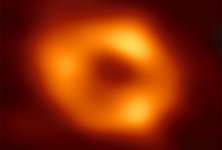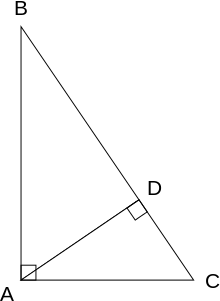Known as Sagittarius A*, the supermassive black hole is a staggering four million times the mass of our Sun.
What you see in the attachment is a central dark region where the hole resides, circled by the light coming from super-heated gas accelerated by immense gravitational forces.
For scale, the ring is roughly the size of Mercury's orbit around our Sun.
What you see in the attachment is a central dark region where the hole resides, circled by the light coming from super-heated gas accelerated by immense gravitational forces.
For scale, the ring is roughly the size of Mercury's orbit around our Sun.
Attachments
Interestingly, the 'hotspots' in the accretion disc move around from "day to day"
"These brighter regions are likely places where material is moving towards us and where its light emission is being energised, or "doppler boosted", as a consequence."
"These brighter regions are likely places where material is moving towards us and where its light emission is being energised, or "doppler boosted", as a consequence."
Cool.First picture of supermassive black hole at centre of Milky Way Galaxy is released:
https://www.bbc.co.uk/news/science-environment-61412463
This time "Picture" as in...?
a) Artistic rendition
b) Kodak moment
c) Colouring of radio waves pattern (see a) )
d( other..
//
Picture, Photo and Image. My English fails me (again...) :-/
Brittanica:
Picture: a painting, drawing, or photograph of someone or something
Image: a picture that is produced by a camera, artist, mirror, etc.
Photo: a picture made by a camera
it's all circular 🙂
//
Brittanica:
Picture: a painting, drawing, or photograph of someone or something
Image: a picture that is produced by a camera, artist, mirror, etc.
Photo: a picture made by a camera
it's all circular 🙂
//
What's your beef?
Radio astronomers have been constructing "images" at radio frequencies for decades.
Radio astronomers have been constructing "images" at radio frequencies for decades.
My beef is mostly with the normal press that implies that this is what you would see with your now eyes if you could take strip watch the thing in person 🙂
//
//
I'm definitely a bit kooky. My wife and kids keep reminding me. When I start to wax lyrical about things scientific, their eyes roll back. 'Here he goes again . . . '
😉
😉
I read a few days ago that Sagittarius A* has been quiet for about 2.6 million yrs (don't know how they came to that, but that's what the article said. There are two enormous gas lobes or bubbles above and below the Milky Way galactic plane that extend about 26k LY (IIRC) each way. The current theory is that when Sgr A* was eating stars in its immediate vicinity, the matter would get accelerated to immense speeds, and would get ejected out of each pole of the BH due to the synchrotron action of the rotating BH and the powerful magnetic and gravitational forces. So, I can only guess that in the past, had you gazed up at the Milky Way, you would have seen two enormous jets ether side of the galactic plane. When Sgr A* stopped ejecting these jets (travelling at 500k miles an hour), the gas and particles would have dispersed, so you now have these diffuse lobes either side of the plane.
There are a few pictures of galaxies where the central BH is 'jetting' and they go out for thousands of light yrs - absolutely spectacular.
There are a few pictures of galaxies where the central BH is 'jetting' and they go out for thousands of light yrs - absolutely spectacular.
My wife and kids keep reminding me.
My wife and kids keep avoiding me! 🤪
I read a few days ago that Sagittarius A* has been quiet for about 2.6 million yrs...
Sagittarious A* 'swept clean' the volume at the heart of the galaxy, consuming those stars which were in range of its gravitational influence.
When it consumed all the nearby material it went into a 'dormant' stage.
Apparently, supermassive black holes can be 'woken up' by intergalactic collisions, during which fresh material comes within their sphere of influence.
There are a few pictures of galaxies where the central BH is 'jetting' and they go out for thousands of light yrs - absolutely spectacular.
Like this jet emerging from galaxy M87, at the heart of which lies the first supermassive black hole that was imaged.
Attachments
I think that if we want to know how universe was constituted just before the moment of inflation, one should envision one (1) single black hole, containing everything.
//
//
a)) A scan of my a**.Cool.
This time "Picture" as in...?
a) Artistic rendition
b) Kodak moment
c) Colouring of radio waves pattern (see a) )
d( other..
//
See one Black Hole, and you've seen them all, IMO! Not spheres but Doughnuts! 😀
Ziri Younsi: "We affectionately term it a doughnut in the collaboration"
https://www.bbc.co.uk/news/science-environment-61412463
I love being right! 😎
Here's my current Physics/Maths project. I want to understand why Einstein was great. Not that he would have been accepted by any University at the time for Tenure.
Not many people know this, but his First great proof was on the old but trusty Theorem of Pythagoras. A stripling 12-y-o. But bright and innovative.
https://www.newyorker.com/tech/annals-of-technology/einsteins-first-proof-pythagorean-theorem
I found that interesting. More interesting, is the whole thing also works with pentagons.
https://en.wikipedia.org/wiki/Pythagorean_theorem#Similar_figures_on_the_three_sides
What is the area of a pentagon? Don't trust the Internet for the answer. This is nonsense:
https://www.wikihow.com/Find-the-Area-of-a-Regular-Pentagon
Wiki would have you believe a pentagon of side length 3 has an area of 15. And a pentagon of side length 7 has an area of 84.... RUBBISH!
It took but a minute on my calculator to find mathematical inconsistencies here. The correct answer is the area is 1.720408163... x Side^2.
I still find Pythagoras interesting. https://oeis.org/A008846
This is because while most people see 25 and don't think about it much, I see 24n + 1. Which to number theorists is the product of two prime numbers of 5 or above!
You see what you want to see!
Ziri Younsi: "We affectionately term it a doughnut in the collaboration"
https://www.bbc.co.uk/news/science-environment-61412463
I love being right! 😎
Here's my current Physics/Maths project. I want to understand why Einstein was great. Not that he would have been accepted by any University at the time for Tenure.
Not many people know this, but his First great proof was on the old but trusty Theorem of Pythagoras. A stripling 12-y-o. But bright and innovative.
https://www.newyorker.com/tech/annals-of-technology/einsteins-first-proof-pythagorean-theorem
https://en.wikipedia.org/wiki/Pythagorean_theorem#Proofs_by_dissection_and_rearrangementEinstein's proof by dissection without rearrangement
Right triangle on the hypotenuse dissected into two similar right triangles on the legs, according to Einstein's proof
Albert Einstein gave a proof by dissection in which the pieces do not need to be moved.[17] Instead of using a square on the hypotenuse and two squares on the legs, one can use any other shape that includes the hypotenuse, and two similar shapes that each include one of two legs instead of the hypotenuse (see Similar figures on the three sides). In Einstein's proof, the shape that includes the hypotenuse is the right triangle itself. The dissection consists of dropping a perpendicular from the vertex of the right angle of the triangle to the hypotenuse, thus splitting the whole triangle into two parts. Those two parts have the same shape as the original right triangle, and have the legs of the original triangle as their hypotenuses, and the sum of their areas is that of the original triangle. Because the ratio of the area of a right triangle to the square of its hypotenuse is the same for similar triangles, the relationship between the areas of the three triangles holds for the squares of the sides of the large triangle as well.
I found that interesting. More interesting, is the whole thing also works with pentagons.
https://en.wikipedia.org/wiki/Pythagorean_theorem#Similar_figures_on_the_three_sides
What is the area of a pentagon? Don't trust the Internet for the answer. This is nonsense:
https://www.wikihow.com/Find-the-Area-of-a-Regular-Pentagon
Wiki would have you believe a pentagon of side length 3 has an area of 15. And a pentagon of side length 7 has an area of 84.... RUBBISH!
It took but a minute on my calculator to find mathematical inconsistencies here. The correct answer is the area is 1.720408163... x Side^2.
I still find Pythagoras interesting. https://oeis.org/A008846
This is because while most people see 25 and don't think about it much, I see 24n + 1. Which to number theorists is the product of two prime numbers of 5 or above!
You see what you want to see!
- Status
- Not open for further replies.
- Home
- Member Areas
- The Lounge
- What is the Universe expanding into..



